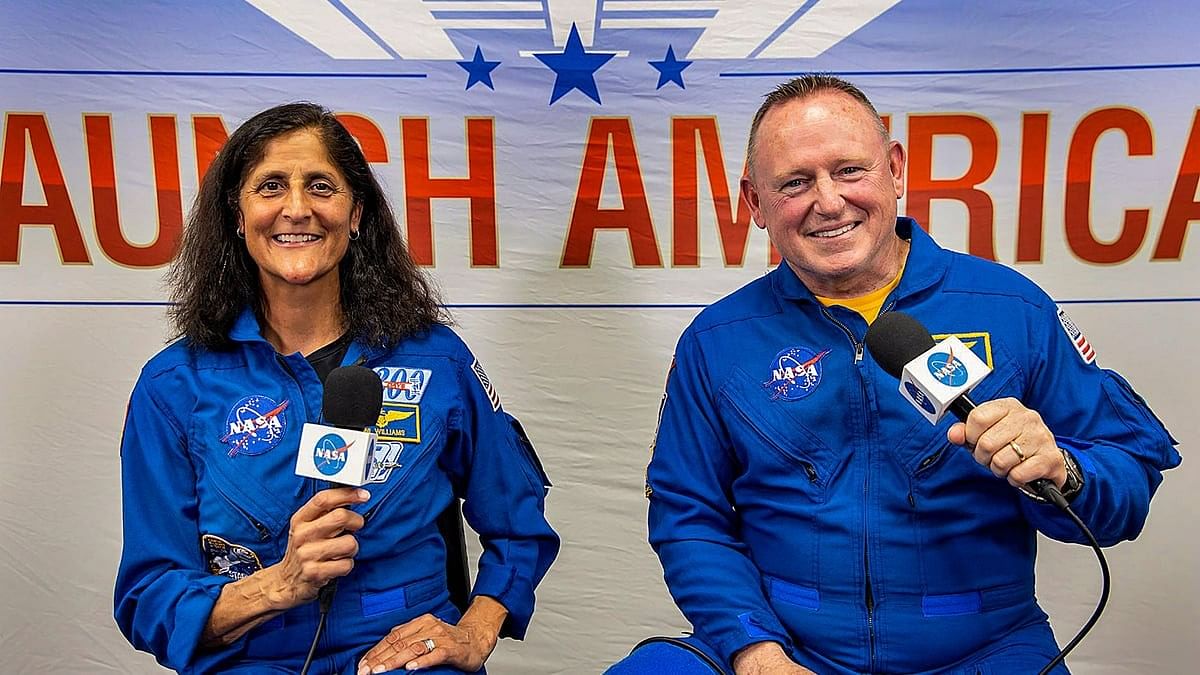
Astronauts Sunita Williams and Butch Wilmore
Credit: PTI File Photo
Houston: On the way to the International Space Station aboard Boeing’s Starliner spacecraft, Indian-origin astronaut Sunita Williams and her colleague Butch Wilmore tested out a unique capability of the spacecraft on orbit – manual piloting.
Williams flew to space for the third time on Wednesday along with Wilmore, scripting history as the first members aboard Boeing’s Starliner spacecraft on a 25-hour flight to the International Space Station (ISS).
Williams, 58, is the pilot for the flight test while Wilmore, 61, is the commander of the mission.
Although the spacecraft is usually autonomous, the crew used the hand controller to point and aim the spacecraft during about two hours of free-flight demonstrations.
During a far-field demo, they pointed Starliner’s nose toward the Earth so that its communications antenna on the back of the Service Module was pointed at the Tracking and Data Relay satellites. They then moved the Starliner so that its solar array pointed at the sun to show they could charge the internal batteries if ever needed, Boeing said in a statement.
Next, they swung Starliner around and pointed the nose away from Earth to look at the stars. This was to show they could manually use the star trackers in the VESTA system to establish their attitude in space in case all three flight computers were to ever go out or be turned off at the same time.
Then, they manually sped Starliner up and then slowed it down, which slightly raised and then lowered their orbit. This was to show that the crew could manually break away from the space station orbit during rendezvous, if necessary.
Finally, the crew manually pointed Starliner in the orientation needed for entry into the Earth’s atmosphere, just in case they had to do that manually. During that manoeuvre, they again pointed the solar array at the sun to try a different method of confirming they could manually charge the batteries.
There is more manual piloting to come for this “pilot’s spacecraft” with Wilmore and Williams on docking day, June 6.
The Starliner spacecraft, dubbed Calypso, has been developed by Boeing, under a contract from NASA. It has run into several delays and glitches in its developmental process.
Moments before lift-off, Commander Wilmore called out to thank all those who had worked to make the mission possible. Alluding to past difficulties, he said: "When the going gets tough - and it often does - the tough get going, and you have.' Starliner's pilot Suni Williams chimed in: 'Go 'Calypso'! (the name of the capsule). Take us to space and back." This mission is a critical venture for manufacturer Boeing, which has been under pressure after a series of safety incidents on its aeroplanes.
Starliner, likewise, has encountered numerous technical issues that have delayed its planned crewed debut by almost a decade.
The most dramatic of these problems occurred on the capsule's first uncrewed test flight in 2019 when software errors forced the vehicle to abort its trip to the ISS. Nasa requested a second dummy run be conducted in 2022 to be sure the errors had been corrected.
Starliner was developed in response to NASA's request for commercial options to get its astronauts into space.
Following the retirement of the famous shuttles in 2011, the agency wanted to move away from owning and operating vehicles to an arrangement where it could simply purchase the service - just like a company might outsource its IT needs or payroll.
The new approach was designed to save NASA money it could then spend on ambitious plans to return people to the Moon.
The agency gave contracts to Boeing and SpaceX to help bring their capsules into service and then pay them for six operational missions. Whereas SpaceX was able to fly its crew flight test in 2020 and then complete six operational missions by March of this year, Boeing is still at the stage of the initial crew flight test.